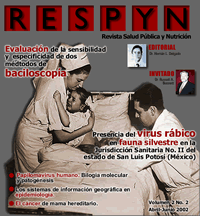LOS SISTEMAS DE INFORMACIÓN GEOGRÁFICA EN EPIDEMIOLOGÍA
Resumen
Los Sistemas de Información Geográfica (SIG) se hanvenido desarrollando por más de 20 años y aplicando en
diversas ramas de la ciencia. En el sector de la salud
pública, en particular en la Epidemiología, los SIG
ofrecen múltiples oportunidades, a la vez que brindan
una perspectiva espacial de las enfermedades,
constituyen una poderosa herramienta para facilitar los
procesos de análisis de información y de toma de
decisiones en los servicios de salud.
Descargas
Citas
Clarke KC, LS Mc Lafferty, and BJ Tempalski 1996. On Epidemiology and Geographic
Information Systems: a review and discussion of future directions.Emerg Infect
Dis.Apr-Jun; 2(2):85-92
Richards TB, CM Croner, G Rushton, CK Brown and L Fowler 1999. Geographic
Information Systems and public health: mapping the future. Public Health Rep. Jul-
Aug;114(4):359-60
Clarke KC, et al, op cit
Idem.
Richards TB, et al, op cit
World Health Organization 1999. Geographical Information Systems (GIS). Mapping
for epidemiological surveillance. Weekly Epidemiological Record; 74(34):281-5
Richards TB, et al, op cit
Pan American Health organization, Special Program for Health Analysis 2000.
Geographic Information Systems in health, basic concepts, Washington, DC:OPS, 92 p.
Organización Panamericana de la Salud 1996 Uso de los Sistemas de Información
Geográfica en Epidemiología (SIG-EPI).Boletín Epidemiológico; 17(1):1-6
Pan American Health Organization, op cit
Fonseca F, and MS Carvalho 1996. Spatial and Temporal Analysis of
Epidemiological Data. Disponible en: http://www.idrc.ca/books/focus/766/nobre.html
Eng SB, DH Werker, AS King, SA Marion, A Bell, JL Issac-Renton, GS Irwin, and
WR Bowie 1999. Computer-generated dot maps as an epidemiologic tool: investigating
an outbreak of toxoplasmosis. Emerg Infect Dis. Nov-Dec; 5(6):815-19
Fonseca F, and MS Carvalho op cit
Bishai WR, NM Graham, S Harrington, DS Pope, N Hooper, J Astemborski, L
Sheely, D Vlahov, GE Glass and RE Chaisson 1998. Molecular and geographic patterns
of tuberculosis transmision after 15 years of directly observed therapy. JAMA.Nov
;280(19):1679-84
Clarke KC, et al, op cit
. Idem
World Health Organization 2001. Geographical Information Systems. Disponible
en:http://www.who.int/emc/healthmap/healthmap.html
Souza WV, R Ximenes, MFM Albuquerque, TM Lapa, JL Portugal, MLC Lima, and
CMT Martelli 2000. The use of socioeconomic factors in mapping tuberculosis risk areas
in a city of northeastern Brazil. Pan Am J Public Health;8(6):403-10
Wilkinson D and F Tanser 1999. GIS/GPS to document increased acces to
comunity-based treatment for tuberculosis in Africa. Lancet;354(9176):394-6
Rogers DJ and BG Williams 1993. Monitoring trypanosomiasis in space and time.
Parasitology;106 Suppl:77-92
Vine MF and D Degnan (1998). Geographic Information Systems. J Environ
Health.Oct;61(3):7-10
Idem
Beyea J, and M Hatch 1999. Geographic exposure modeling: a valuable extension
of geographic information systems for use in environmental epidemiology. Environ
Health Perspect, Suppl; 107(1):181-90
Idem
Glass GE, BS Schwartz, JM Morgan III, DT Johnson, PM Noy and E Israel 1995.
Environmental risk factors for Lyme disease identified with geographic information
systems. Am J Public Health. Jul;85(7):944-8
Nicholson MC and TN Mather 1996. Methods for evaluating Lyme disease risks
using geographic information systems and geospatial analysis. J Med Entomol.
Sep;33(5):711-20
Clarke KC, et al, op cit
Idem.
Richards TB, et al, op cit
Idem.
Descargas
Publicado
Cómo citar
Número
Sección
Licencia
Derechos de autor 2001 Ivette Molina Serpa

Esta obra está bajo una licencia internacional Creative Commons Atribución 4.0.
Los derechos del trabajo pertenecen al autor o autores, sin embargo, al enviarlo a publicación en la Revista Salud Pública y Nutrición de la Facultad de Salud Pública y Nutrición de la Universidad Autónoma de Nuevo León, le otorgan el derecho para su primera publicación en medio electrónico, y posiblemente, en medio impreso a la Revista Salud Pública y Nutrición. La licencia que se utiliza es la de atribución de Creative Commons , que permite a terceros utilizar lo publicado siempre que se mencione la autoría del trabajo y a la primera publicación que es en la Revista Salud Pública y Nutrición. Asimismo, el o los autores tendrán en cuenta que no estará permitido enviar la publicación a ninguna otra revista, sin importar el formato. Los autores estarán en posibilidad de realizar otros acuerdos contractuales independientes y adicionales para la distribución no exclusiva de la versión del artículo publicado en la Revista Salud Pública y Nutrición (p. ej., repositorio institucional o publicación en un libro) siempre que indiquen claramente que el trabajo se publicó por primera vez en la Revista Salud Pública, Revista de la Facultad de Salud Pública y Nutrición de la Universidad Autónoma de Nuevo León.










